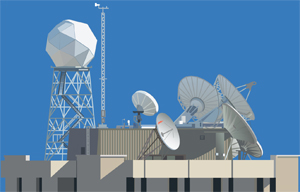 |
Director's NoteFred Best |
SSEC, in association with the AOS department, has accumulated an impressive array of ground-based instrumentation for making various measurements of the atmosphere. The data from many of these instruments is continually collected, archived, and made available for downloading through the Ground-based Atmospheric Monitoring Instrument Suite (GAMIS) webpage.
This site will connect you with data from instruments at our building (AOSS) as well as from the Lake Mendota Buoy, which is a collaborative project between SSEC, Limnology, and Environmental Engineering. The AOSS instrument suite provides measurements every five seconds of temperature, humidity, wind direction and speed, pressure, precipitation, and solar radiation, all from the 15 meter tower on top of the penthouse. At varying times there is also data available from an Atmospheric Emitted Radiance Interferometer (AERI), and a High Spectral Resolution Lidar (HSRL).
We also currently have images available every 10 seconds from three cameras (pointing North, North West, and West). In the future we hope to have both an AERI and HSRL on-line at all times. SSEC also maintains a Winnebago traveling laboratory that was originally designed to house an AERI (hence the name AERIbago) and a radiosonde ground station. There are plans to add an HSRL to this laboratory. The Winnebago system is showing its age and we are in the process of evaluating a trade between maintaining the current system or looking for a new capability.
There are other instruments here at SSEC that are not connected to the centralized data collection system. These include two instruments located on the roof of the Engineering Research Building that are connected to a NOAA data system: a pyrgeometer (that measures downwelling infrared radiation) and a multi-filter rotating shadow band radiometer. We also have an all-sky camera and laser ceilometer (cloud height sensor) that are currently off-line.
The instruments described above, along with the underlying data system, have been funded through several different small projects and with SSEC overhead. New projects continue to bring in more and more sophisticated capability. Here are examples of some of the new instruments that will soon be available:
- Ankur Desai will be bringing in a spectroscopic system for making precise (ppb) in-situ simultaneous measurements of CO2, CO, CH4, and H2O (this system will be located in room 1553)
- Bob Holz has a grant to bring in a solar tracking instrument that will retrieve cloud optical thickness and effective particle radius
- Brad Pierce has obtained funding for a CIMEL sun photometer to be located in Madison as part of the AERONET system.
Because of the ever-expanding scope and scale of the ground-based science and instrumentation within SSEC and AOS, and because of the growing list of users that rely on the data collected, we are setting up a new coordination group to help organize activities and us move efficiently into the future. The new coordination group will be will be overseen by a Science Team that will be led by Bob Holz, and will include Ralf Bennartz, Ankur Desai, Ed Eloranta, Wayne Felz, Grant Petty, Brad Pierce, and Dave Turner. The organization of the Coordination Group is now envisioned to be as shown below in Figure 1. The roles other than the Science Team will be identified in the near future.

Figure 1. Ground-based instrumentation Coordination Group organization.
The role of the Coordination Group is outlined below:
- Develop and maintain a strategic scientific vision for the ground-based instrumentation with regards to the overall mission of SSEC and AOS.
- Help establish priorities and funding mechanisms for instrument and infrastructure needs.
- Individual instrument procurements and/or upgrades
- Data acquisition, archive, retrieval, display, data base tools or H/W & S/W
- Collaborations with outside groups
- Help identify areas of scientific collaboration
- Help identify educational opportunities for students at all levels.
- Coordinate with groups inside and outside the building that now have, are now developing, or are proposing to obtain instrumentation or instrumentation upgrades.
- Oversee instrument calibration.
- Develop & implement calibration plans, procedures, and schedules.
- Track status (and find way to integrate status into data stream).
- Spares plan (rotate inexpensive sensors).
- Coordinate and prioritize requests for instrumentation to support field programs.
- Coordinate new instrument sighting needs with respect to available space, synergy with other instruments, and future planned instruments and antenna systems
If you have any instrumentation needs, ideas for collaboration, or ideas you would like considered, please contact a member of the science team. We will use future editions of “In the News” and "From Orbit" to keep people up to date on ground-based instrument activities.

